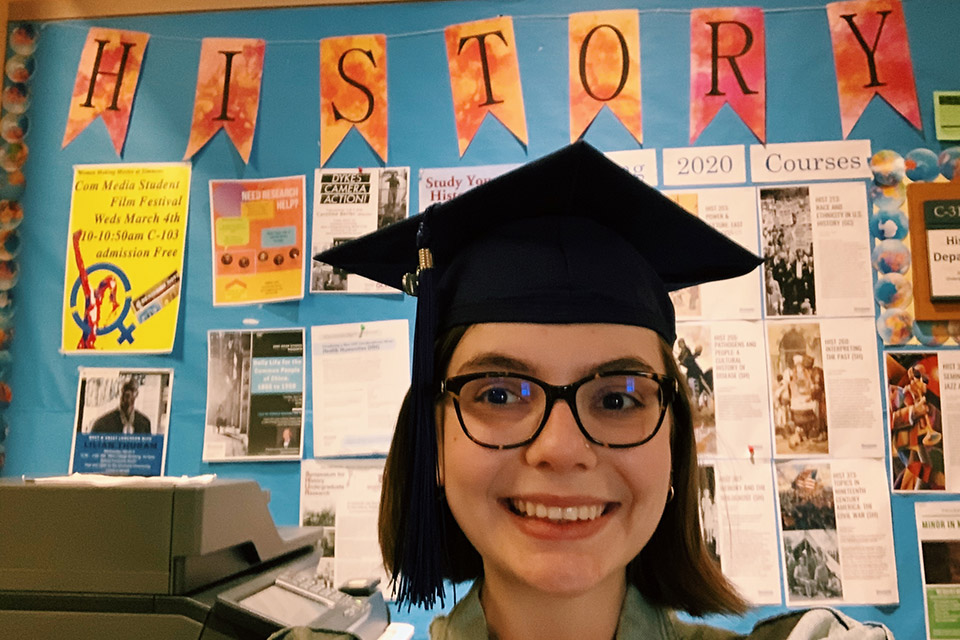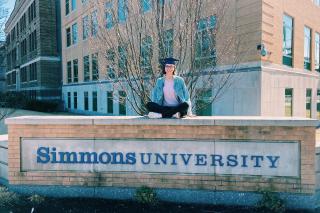Why did you decide to come to Simmons?
I remember a moment at an accepted student's day, where I was sitting in a faculty panel. A professor told a story of teaching a guest lecture at another institution, and only men in the room participated in class. It had never struck me until that moment how valuable a women-centered education could be.
Also, I loved the location in Boston, as I knew it would open the door to many internships (such as the Barbara Lee Fellowship!), but I wanted the small campus feel and the small class sizes.
What are you studying?
I double major in political science and history. My specialization in history is United States women’s and gender history!

How did you decide to study queer and gendered spaces in settlement houses?
I arrived at my topic in a meeting with my advisor, Dr. Laura R. Prieto. I knew I wanted to apply to SURPASs, but I didn’t have a concrete idea for a project. So, we brainstormed! I said that I was interested in settlement houses, and I’m interested in queer history, and Laura pointed out that there is an existing overlap in those two topics! It perfectly combined my interest in queer theory and the women-centered nature of settlement houses in the United States, and I knew I had my topic!
Give us a brief synopsis of your project.
For those who may not know, settlement houses were institutions, usually created by women, in the late nineteenth and early twentieth-century urban spaces with the purpose of providing programming and safe lodging for mostly immigrant and working-class populations. Many of the founders of the settlement houses, such as Lillian Wald and Jane Addams, are already broadly accepted into the narrative of queer history, but no one has really studied how that might have impacted the working-class community members who visited the houses. I’m working to fill that gap in the scholarship!
So, after much study in the archives, I picked three spaces that settlement houses created to analyze how the may have offered queer spaces, or even just spaces that were primarily for working-class women, which would have been pioneering as well. I studied Denison House, which was a Boston settlement, and Henry Street House, which was in New York City.
What were your findings?
Ultimately, it’s challenging to say. I knew going into my project that there would almost certainly be no “smoking gun” document that described a relationship at a settlement house between two women or two men. But, I can confidently say that both houses offered pioneering women’s only spaces for working-class women, in an era when no others really existed!
Describe what you meant by reading the "silences in the records."
Around 1890-1930 queerness as an identity did not yet exist. Terms we know such as “lesbian” or “gay” or “bisexual,” therefore, did not exist either. It was a thing people did, not a thing people were. And it was most certainly not something people were, for the most part, openly documenting as something they took part in (and if they did, these documents were often destroyed later, either by the person themselves or a family member looking to preserve a reputation).
So, I had to read the silence in the records, reading into what a document does not say as much as it actually does. One example of this in my research is how Denison House documented an all-men production of The Merchant of Venice, a production in which, of course, cross-dressing occurred. The documents from the leadership of the house commented simply that the production was most successful, but did not acknowledge the cross-dressing. This silence left me contemplating whether or not this was a tacit acceptance of a potentially queer behavior or a cautionary avoidance of mentioning it in the records.
What did you learn from this experience?
I learned SO much from this experience. Looking beyond what actual historical material I learned in my time at the archives and doing my countless readings, I learned much about myself as an academic, a writer, and a student.
I began this project in June 2019, and I will be handing in my final thesis in May 2020. This project was massive and taught me patience in watching my endeavors come to fruition. It taught me how to manage my time in archival study and in writing. But I think that above all, it taught me that I have something important to contribute to the field of queer history and that my voice deserves to be listened to!
How did it feel to be accepted as a keynote speaker for the Undergraduate Symposium?
It felt incredible to be accepted as a keynote speaker for the Undergraduate Symposium! I'm proud that my project fulfilled the criteria to be a good candidate, and I'm hopeful that it will be able to resonate with the community.
Do you have a favorite Simmons memory?
It’s so hard to pick just one! Some of my favorite memories come from living on campus over the summer when I participated in SURPASs. We were all living in Simmons Hall, where I had lived during my first year, so it was the warmest and most joyful déjà vu.
It kind of felt like summer camp! All of the scholars made friends with each other so quickly through our common experience, even though everyone’s projects were so different! We cooked together, watched movies in the evenings, and gave each other advice on how we were handling our projects. I had a blast and miss it so much!

